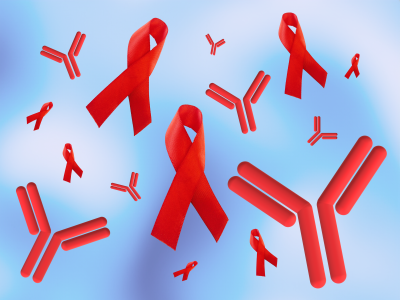NIAID-supported Clinical Studies Assess Therapeutics for Clearance of HIV from the Reservoir
Antiretroviral therapy (ART) has been a game-changer for people with HIV. But HIV is skilled at “hiding” and can reappear in the blood stream shortly after ART is stopped. That’s why NIAID and partners are investigating strategies to completely clear HIV from a person’s body, effectively curing them, or to reduce it to levels that can be suppressed by their own immune systems.
Many promising HIV cure strategies use broadly neutralizing antibodies, or bNAbs, which can neutralize a wide range of HIV variants, homing in on and binding to specific viral components, and then acting to destroy the virus by triggering an immune response. Several HIV bNAbs have been developed and tested to determine whether they can prevent or treat HIV. NIAID and partners are evaluating bNAb-based strategies alone and in combination with other immunity-enhancing strategies for HIV clearance in clinical trials in Africa, North and South America, and Southeast Asia.
Finding a cure for HIV is complex, largely due to the tenacity of the virus—it can persist in some tissues or cells without being attacked by the immune system. This is even the case for people whose viral load—the amount of virus in the blood—is suppressed below a level that can be detected by routine diagnostic tools. As a result, most people who experience an interruption in treatment will experience a viral rebound, in which the previously dormant virus begins to replicate and can attack the immune system. This problem is especially urgent for people with HIV who have limited access to treatment, including those in areas with limited resources. A treatment that can be given for a limited time to stop the virus from replicating long term, or one that removes it from the body entirely, could eliminate the need for lifelong treatment, improve quality of life for people with HIV, and reduce further HIV transmission.
Two studies beginning this summer are assessing the use of bNAbs to enable HIV remission in people with HIV in African countries. Both studies will include closely monitored ART interruption to examine whether bNAbs can lead to long-term ART-free control of HIV. One trial, called Pausing Antiretroviral Treatment Under Structured Evaluation (PAUSE), enrolled its first participant in June 2024 and continues to enroll people with HIV in Botswana, Malawi, and South Africa. Participants on ART with no detectable virus in their blood stream will receive two long-acting bNAbs (3BNC117-LS-J and 10-1074-LS-J) and then pause ART to determine whether the bNAbs are sufficient to control HIV in the body when ART is stopped.
A second study, called Antiretrovirals Combined With Antibodies for HIV-1 Cure In Africa (ACACIA), is starting soon and will examine the bNAbs 3BNC117-LS (also known as teropavimab) and 10-1074-LS (also known as zinlirvimab) in adults living with HIV in Botswana, Malawi, South Africa and Zimbabwe who are beginning ART. The bNAbs will be given while there is still virus in the blood stream to see if they can enhance the body’s immune response to HIV, which could reduce the amount of virus that hides in viral reservoirs in the body. Once the bNAbs are no longer present in the body, ART will be interrupted for each participant, and they will be evaluated to determine how long viral suppression is maintained without ART and whether the bNAbs affect the immune response to HIV.
Researchers are also evaluating bNAb-based HIV cure strategies in children through the International Maternal Pediatric Adolescent AIDS Clinical Trials (IMPAACT) Network. The IMPAACT P1115 study has examined very early HIV treatment strategies in infants who were exposed to or acquired HIV before birth. The study is assessing VRC01 and VRC07-523LS to see whether these bNAbs, when given with ART early in life, may enable ART-free remission in children. Another study, IMPAACT 2042, will evaluate the use of three bNAbs, VRC07-523LS, PGDM1400LS, and PGT121.414.LS, in children and young adults with HIV between the ages of 2 and 25 to determine whether the bNAbs can be part of a strategy to suppress HIV and clear the virus from the body.
Other clinical studies are combining bNAbs with therapeutic vaccines for HIV clearance. These vaccines are designed to improve the immune response to the virus in a person with HIV. ACTG A5374, which enrolled its first participant in early 2024, is evaluating the bNAbs teropavimab and zinlirvimab in combination with the therapeutic vaccines ChAdOx1.HIV cons1/62 and MVA.HIV cons3/4 and an immune booster called vesatolimod. The trial will assess the safety of the regimen in people with HIV in the U.S. and Brazil, and whether the combination can eliminate cells harboring HIV and prevent viral reservoirs from reactivating when ART is interrupted.
The findings from these and related trials will provide researchers with new insights into how to effectively treat HIV or clear the virus from people’s bodies. This work is implemented by leveraging the strengths of all of the NIH-funded HIV clinical trials networks and collaborating institutions. The Bill & Melinda Gates Foundation is co-funding PAUSE and ACACIA. IMPAACT P1115 and 2042 are co-funded by the NIH’s Eunice Kennedy Shriver National Institute of Child Health and Human Development.
The bNAbs VRC01 and VRC07-523LS were developed by NIAID’s Vaccine Research Center and Division of Intramural Research. The bNAbs 3BNC117 and 10-1074 were discovered by researchers at the Rockefeller University, funded in part by NIAID. PGT121.414.LS and PGDM1400LS are being developed by NIAID and collaborators.
Additional information about the trials:
- ACTG A5374: ClinicalTrials.gov ID NCT067071767.
- ACTG A5416 (also called PAUSE): ClinicalTrials.gov ID NCT06031272.
- ACTG A5417 (also called ACACIA): ClinicalTrials.gov ID NCT06205602.
- IMPAACT P1115: ClinicalTrials.gov ID NCT02140255. (Recent P1115 findings were presented at the 2024 Conference on Retroviruses and Opportunistic Infections.)
- IMPAACT 2042 (also called Tatelo Plus): ClinicalTrials.gov ID coming soon.


